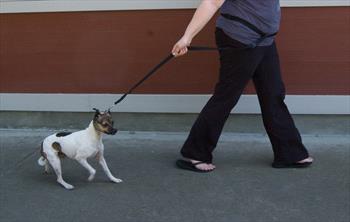Question:
I have a three year old male, neutered Shih Tzu named Pocky. My problem is that while other dogs drag their owners on walks, I have to constantly pull on Pocky’s leash so that he will walk with me. When he does, he is at least 2–4 feet behind me even though I walk at a leisurely pace. I have tried treats while walking but he is not interested. When we are ready to turn back and walk home, Pocky perks up and walks closer to me but still behind. I’ve seen him run happily when chasing cats and racooons, but he just doesn’t like to take walks. What should I do?
Answer:
If Pocky’s a fit and trim Shih Tzu rather than a fluffy log on wheels, and he runs around at home and in your yard, but drags his feet on walks in public, then his pokey problem may indicate a slight fear of public places. Here’s how you test it. Take him to a local dog park or some other enclosed dog-safe area and let him run off lead. Does he boldly explore like a dog on a mission or does he shadow your every step like a well-paid vallet? And when a friendly dog or unfamiliar human appears, does Pocky duck for cover or comfortably extend a greeting?
If he lags behind like you’re his human shield and refuses his favorite treats, then he could be shy in public. Such dogs can be either sweet and calm at home or can rambunctious and unruly, but once they get in public they take a tentative turn. For some dogs it’s the traffic and loud sounds that cause them to balk; for others it’s the sight of unfamiliar people and dogs. In both cases the bowser may be so uneasy that he doesn’t want to eat. Even so, a really tempting distraction, such as a darting cat, can make such a dog forget his fears and send him into a heated chase.
There are several reasons why a dog might develop into a bashful bowser. The most common scenario is that he needed more practice seeing new sites and meeting more people and dogs early in his first year of life. If this is the case with Pocky, count yourself lucky, because a very different response to a history of sparse socialization is that the under-socialized dog frequently lunges and barks on walks creating a ludicrous and even dangerous scene.
Pocky could be pokey for other reasons too though. For one, he could just dislike walking on leash. If that’s the case, he’ll run like the dickens or explore unabashedly when “free” but put him on the leash and suddenly he’s as docile as a doormat. In this case and the first, pulling him can make things worse because then he just associates his walk with more unpleasant things. You can change his attitude in a more positive way though. Here’s how you might start.
First, if Pocky starts to look demure as soon as you pull out the leash, then spend a couple of days teaching him that the leash signals good things are about to happen. Instead of walking him outside, just snap the leash on him and play with him for a few minutes inside. Or start by putting a tasty treat such as peanut butter or canned spray cheese on the leash for him to lick off and, once he wags his tail whenever he sees the leash, you can snap it on. Then, play with him and give him special treats that you reserve just for this leash game. Once the fun and games are over, remove the leash and ignore him for a few minutes.
When Pocky’s predictably happy to get his leash on, you can start taking him out in front of the house, but instead of taking him on a walk, just play with him and give him his treats. In future sessions, play with him a little down the street. How far depends on what he does. If he no longer takes treats then you’re too far from home. Gradually work your way farther from the house, distracting him with play and treats. When you’ve worked up to a block—which may take days or weeks—then try taking him on a walk halfway down the block before you stop to offer play and treats.
At some point you will reach a critical distance where, from then on, he’ll just keep up with you like a regular dog. At this point, intermittent treats and play along the walk will continue to reinforce the good walking behavior. If he’s extremely fearful in the walk situation though, this training will take much longer and may require help from a behavior specialist.
Lastly, before embarking on a potentially long drawn out plan, have your veterinarian examine Pocky thoroughly. Medical conditions such as joint disease, heart and lung abnormalities and neuromuscular problems could cause him to lag too.



